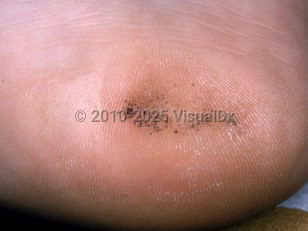Talon noir in Adult
Alerts and Notices
Important News & Links
Synopsis

Talon noir, also referred to as calcaneal petechiae, is an asymptomatic discoloration of acral skin that results from intraepidermal hemorrhage caused by shear-force injuries. Talon noir translated from French means black heel. It most aptly describes lesions upon the feet, particularly the heel, but lesions upon the hand or other sites can also occur. Some dermatologists use the same nosology to refer to both processes. Because the condition can be seen in varied locations and for varied reasons, some dermatologists have suggested the term posttraumatic cutaneous intracorneal blood.
Talon noir tends to affect the posterior foot, the heel, the lateral foot, and the palm. Athletic events often produce lateral shearing forces that cause tearing of blood vessels in the papillary dermis. This creates punctate papillary dermal hemorrhages, leading to extravasation of blood into the epidermis and intracorneal retention of hemoglobin. Because of its location in the stratum corneum, it cannot be cleared by phagocytic cells.
Basketball, lacrosse, football, soccer, and cross-country running are frequent causes of talon noir.
The condition is asymptomatic, and because it is painless, the etiological events are often unrecognized. Because of the discoloration and generally rapid acquisition, patients may be concerned that they have an acral melanoma.
Talon noir tends to affect the posterior foot, the heel, the lateral foot, and the palm. Athletic events often produce lateral shearing forces that cause tearing of blood vessels in the papillary dermis. This creates punctate papillary dermal hemorrhages, leading to extravasation of blood into the epidermis and intracorneal retention of hemoglobin. Because of its location in the stratum corneum, it cannot be cleared by phagocytic cells.
Basketball, lacrosse, football, soccer, and cross-country running are frequent causes of talon noir.
The condition is asymptomatic, and because it is painless, the etiological events are often unrecognized. Because of the discoloration and generally rapid acquisition, patients may be concerned that they have an acral melanoma.
Codes
ICD10CM:
S90.30XA – Contusion of unspecified foot, initial encounter
SNOMEDCT:
21143006 – Calcaneal petechiae
S90.30XA – Contusion of unspecified foot, initial encounter
SNOMEDCT:
21143006 – Calcaneal petechiae
Look For
Subscription Required
Diagnostic Pearls
Subscription Required
Differential Diagnosis & Pitfalls

To perform a comparison, select diagnoses from the classic differential
Subscription Required
Best Tests
Subscription Required
Management Pearls
Subscription Required
Therapy
Subscription Required
References
Subscription Required
Last Reviewed:08/12/2020
Last Updated:09/03/2020
Last Updated:09/03/2020
 Patient Information for Talon noir in Adult
Patient Information for Talon noir in Adult
Premium Feature
VisualDx Patient Handouts
Available in the Elite package
- Improve treatment compliance
- Reduce after-hours questions
- Increase patient engagement and satisfaction
- Written in clear, easy-to-understand language. No confusing jargon.
- Available in English and Spanish
- Print out or email directly to your patient
Upgrade Today

Talon noir in Adult

